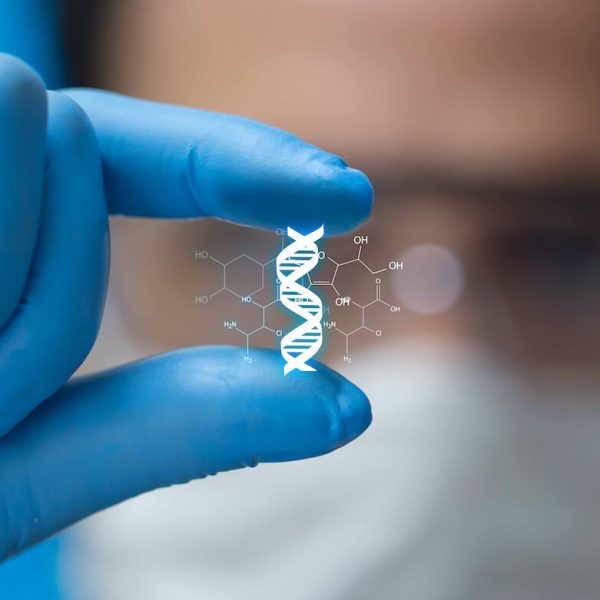Gene Diagnostics
Rapid Whole Exome Sequencing
SECTION: GENOME ANALYSIS
For some patients visiting the Gynecology, Neonatology, and Clinical Genetics centers at Amsterdam UMC, a timely genetic diagnosis is critical to select an effective treatment or help make informed decisions. However, standard diagnostic analysis to identify genomic causes of disease takes too long for some patients. To address this care gap, Amsterdam UMC Genome Diagnostics developed a new expedited Whole Exome Sequencing pipeline in 2022. Abeltje Polstra, Silvana van Koningsbruggen, and Mariëlle Alders answer questions.

What is Whole Exome Sequencing (WES)?

WES is a genetic test that reads the DNA code (nucleotides) of the protein-coding regions of all recognized genes in the human genome. These exons are regions of an individual’s DNA that provide instructions for making proteins and make up about 1-2 percent of a person’s entire genome.
Determining the order of the DNA building blocks, called DNA sequencing, allows identification of any variations in the protein-coding region of your genes. Because most known mutations that cause disease occur in exons, whole exome sequencing is considered a cost-effective and efficient way to identify possible disease-causing mutations.
Why are you doing rapid WES?
In gynecology, neonatology, and clinical genetics, there is a need to perform WES with urgency to provide timely information that supports decision making and improve care for patients with specific genetic diseases. Getting results quickly is particularly important in prenatal diagnostics and neonatology where time is of the essence for meaningful medical interventions and parents’ informed decision making.
How did you implement rapid WES?
At the beginning of the project, we investigated whether it was an option to speed up the lab process for these specific samples. However, this turned out to be more complex than expected and did not deliver the intended results. It was therefore decided to keep the lab flow the same (as much as possible) for all samples. Improving the existing WES lab flow was already on the agenda and partly because of this, a completely renewed lab flow for the entire WES was realized.
This involved the purchase of a NextSeq sequence machine. With this benchtop next-generation sequencing system, we combine the power of high-throughput sequencing with speed and simplicity. This allows us to schedule everything as tightly as possible and thus achieve short turnaround times of about two weeks.
More information and news from the Section Genome Diagnostics is available here:
Diagnostiek aanvragen bij Laboratorium Genoomdiagnostiek Amsterdam UMC

The Power of Reflection
An Online Support Platform to Advance Care for Patients with Connective Tissue Disorders
SECTION: CENTER FOR CONNECTIVE TISSUE DISEASES
There are many human hereditary disorders that affect connective tissues. These diverse tissues support, connect, and protect different parts of our bodies. Connective tissue disorders include many diseases that have defects in the structure or formation of collagen, a major protein in connective tissue responsible for providing strength.
For some collagen-related connective tissue disorders – such as Osteogenesis Imperfecta (OI), also known as ‘brittle bone disease’, and Ehlers Danlos Syndrome (EDS), a disorder characterized by vulnerable skin structure, joints, and blood vessel walls – very little progress has been made regarding effective treatment options. Considering the wide distribution of collagen in the human body, it is not surprising that these patients present diverse multisystemic manifestations which greatly impact their quality of life.
Improving quality of life for patients with connective disorders
Therapeutic advancements for severe and prevalent collagen-related diseases are a main area of research at the Center for Connective Tissue Diseases. “We have established several lines of investigation into the development of effective treatments for Osteogenesis Imperfecta,” says Dr. Dimitra Micha, head of the section. “In addition, we are currently exploring various pharmacological, cell, and gene therapy approaches in preclinical disease models.”
In order to intensify these efforts, the online Power of Reflection platform was initiated as a means to bring together experts from the connective tissue and collagen fields from several academic medical centers in the Netherlands, including basic science researchers and medical professionals. Their stated mission is to improve the quality of life for patients with connective disorders.
“With this initiative, we hope to make a big step towards increasing awareness for collagen-related connective tissue disorders and, most importantly, contribute to progress in finding a cure,” Dr. Dimitra Micha.
Creating awareness and support
The Power of Reflection kickoff meeting took place in October 2022 at the new location of the Center for Connective Tissue Diseases in the O2 building, Zuidas Amsterdam. Representatives from various medical centers gave presentations. An important topic on the meeting’s agenda was identifying effective means of dealing with pain, which remains an under-addressed aspect of connective tissue disorders.
Dr. Micha. “We intend to harness the synergistic expertise facilitated by this platform to connect and join forces to realize true progress in treating these challenging diseases.”
More information and news from the Section Center for Connective Tissue Diseases is now available on their recently launched website: centerconnectivetissue.nl.